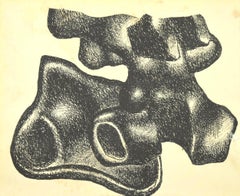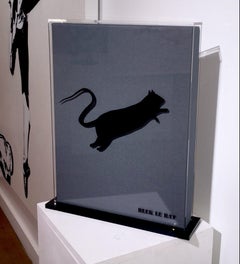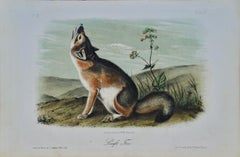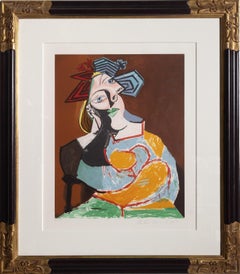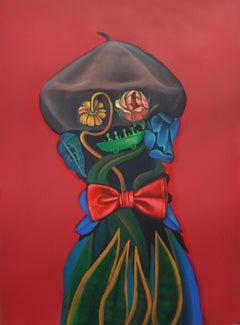Dog Portrait Prints
to
4
14
1
1
2
Overall Width
to
Overall Height
to
4
4
3
1
1
1
1
1
1
5
5
3
5
1
1
4
11
5
1
2,783
6,474
3,537
3,066
2,619
1,888
1,527
1,212
1,100
910
796
738
440
385
383
248
220
200
193
174
7
4
3
2
1
1
11
8
7
Art Subject: Dog
Composition - Original Lithograph after F. Léger - 20th Century
Located in Roma, IT
Composition is an original lithograph on paper realized by Fernand Léger (1881-1955).
Very good conditions except for some little foxings.
Sheet dimension: 23.5 x 26
On both sides...
Category
20th Century Cubist Figurative Prints
Materials
Lithograph
Classik Box
By Blek Le Rat
Located in Dallas, TX
Classikbox – 2016
by Blek the rat
Art casing – Ed.100
Containing 3 serigraphs Ed.100
The man who walks through walls / Madonna and Child / Beggar
Screen-p...
Category
21st Century and Contemporary Street Art Portrait Prints
Materials
Plexiglass, Screen
$2,880 Sale Price
20% Off
Las Meninas
Located in Brooklyn, NY
This etching reproduction of Las Meninas was produced by the Louvre Museum, meticulously capturing the essence of Velázquez’s most iconic masterpiece. Printed using the calcolgraphie...
Category
16th Century Renaissance Portrait Prints
Materials
Etching
$320 Sale Price
20% Off
Swift Fox: An Original 19th Century Hand-colored Lithograph by John J. Audubon
Located in Alamo, CA
This is an original 19th century John James Audubon hand-colored lithograph entitled "Swift Fox", No. 11, Plate LII, from Audubon's "Viviparous Quadrupeds of North America", printed ...
Category
Mid-19th Century Naturalistic Animal Prints
Materials
Lithograph
Original "Gulflex Lubrication for your car" Best Care Pays vintage poster
Located in Spokane, WA
Original “Gulflex Lubrication for your car” vintage poster. Linen backed in very fine condition, ready to frame. No tears, no folds, no paper loss. This series of posters for Gulf Oil and Gulflex were designed to be displayed for 2 weeks and then removed.
This series of posters for Gulflex Lubrication has a different image at the top. This is one of the most interesting designs with the woman grooming her cocker spaniel and reads “Best Care Pays”.
Looking for an original vintage poster to add to your collection? We have a wide selection of original vintage posters for sale, including this striking Gultlex lubrication poster from the mid-20th century.
These posters were once used for promoting everything from movies and advertisers to political campaigns...
Category
1950s American Realist Animal Prints
Materials
Offset
$798 Sale Price
20% Off
Muff, a favorite Retriever - Etching by Joseph Banks - 1837
Located in Roma, IT
Muff, a favorite Retriever is an artwork, realized by the artist Joseph Banks in 1837.
Colored etching, titled and signed in the plate.
Beautiful engraving with contemporary colour...
Category
1830s Modern Figurative Prints
Materials
Etching
Persian Medal- Triumph of Alexander the Great - Lithograph - 1862
Located in Roma, IT
Persian Medal- Triumph of Alexander the Great is a lithograph on paper realized in 1862.
Titled on the lower.
The artwork belongs to the Suite Uses and customs of all the peoples o...
Category
1860s Modern Figurative Prints
Materials
Lithograph
Discours D'oiseaux #4, etching of birds by Marjan Seyedin
Located in Palm Springs, CA
One of 9 humorous portraits of birds engaged in conversation by Franco-Iranian artist Marjan Seyedin. In her works, birds and animals provide an allegorical representation for mankin...
Category
2010s Contemporary Animal Prints
Materials
Etching
$280 Sale Price
20% Off
Camel - Drawing by follower of Stefano Della Bella - 18th Century
Located in Roma, IT
Camel is an artwork realized in the 18th Century by an artisti follower of Stefano della Bella.
Pencil Drawing.
The artwork is in good conditions .
The artwork is depicted skill...
Category
18th Century Old Masters Drawings and Watercolor Paintings
Materials
Pencil
Earl Waldegrave coat of arms
Located in Middletown, NY
London: c 1750. Steel engraving on cream wove paper, 5 3/8 x 6 3/8 inches (sheet) (142 x 162 mm), margins trimmed inside the platemark. Scattered handling wear, creasing and edge nic...
Category
Mid-18th Century English School Portrait Prints
Materials
Engraving, Etching
A Pair Of Animals Triptych, Katie Edwards, Limited Edition Prints, Animal Art
Located in Deddington, GB
A Pair Of Animals Triptych by Katie Edwards
Consists of
A Pair Of Flamingos
A Pair Of Penguins
A Pair Of Elephants
Each piece is individually £50
Sol...
Category
2010s Contemporary Animal Prints
Materials
Silk, Paper, Screen
Les Cinq Enfants de Charles 1er - Etching by Felix-Augustin Milius - 1872
Located in Roma, IT
Etching realized by Félix Milius d'après Van Dyck in 1872.
Very good condition.
Category
1870s Modern Landscape Prints
Materials
Etching
French Customs in the X and XI Centuries - Lithograph by Auguste Wahlen - 1844
Located in Roma, IT
French Customs in the X and XI centuries is a lithograph made by Auguste Wahlen in 1844.
Hand colored.
Good condition.
At the center of the artwork is the original title "Costumi ...
Category
1840s Modern Figurative Prints
Materials
Lithograph
Ancient Roman Frescoes - Original Etching by Nicolò Vanni - 18th Century
Located in Roma, IT
Ancient Roman Frescoes, from the series "Antiquities of Herculaneum", is an original etching on paper realized from a design by Nicolò Vanni in the 18th century.
Signed on the plate...
Category
18th Century Old Masters Figurative Prints
Materials
Etching
Ancient Roman Frescoes - Original Etching by Giovanni Morghen - 18th Century
Located in Roma, IT
Ancient Roman Frescoes from the series "Antiquities of Herculaneum", is an original etching on paper realized by Giovanni Morghen in the 18th century.
Signed on the plate.
Good con...
Category
18th Century Old Masters Figurative Prints
Materials
Etching
Mychael Barratt, Cindy Sherman’s Dog, Limited Edition Print, Affordable Art
Located in Deddington, GB
Mychael Barratt
Cindy Sherman’s Dog
Limited Edition Print
Edition of 50
Sheet Size: H 40cm x W 38cm
Signed and Titled
Sold Unframed
Please note that in situ images are purely an indi...
Category
21st Century and Contemporary Contemporary Animal Prints
Materials
Paper, Digital
Uncle Vanja
Located in London, GB
FEDOR LOEVENSTEIN LOWENSTEIN 1901-1947
(Czech / French)
Title: Uncle Vanja, early 1920’s
Technique: Original Hand Signed, Inscribed and Titled Woodcut on thin wove paper
Paper Size: 27.5 x 21 cm / 10.8 x 8.2 in
Plate Size: 14.8 x 10 cm / 5.8 x 3.9 in
Additional Information: This work is hand signed in pencil by the artist "F. Loevenstein" at the lower right margin.
It is also tilted "Onkel Wanja" (Uncle Vanja) and inscribed "Handabzug" (Hand printed) in pencil at the lower left margins.
This work was printed in the early 1920's in a small edition.
Originally from Czechoslovakia, Fédor Löwenstein (Munich, 1901 - Nice, 1946) studied art in Germany before moving to Paris in 1923, attracted by its artistic influence. There he mixed with the painter André Lhote from Bordeaux and joined the Groupe des Surindépendants in 1936.
His style evolved from Cubism to a form of Romantic abstraction. In 1938, he painted La Chute (The Fall), inspired by the signing of the Munich Agreement ratifying the dismantling of the Czechoslovakia created in 1918. France’s entry into the war drove him to leave the capital for Mirmande, a ruined village in the Drôme region, where Lhote held a summer academy. Löwenstein then divided his time between Mirmande and Nice where his mother and sister lived, but had to take refuge for a time in the Abbey of Aiguebelle. He fell ill in the autumn of 1943 and went to Paris to see a doctor; he died in Nice in 1946.
Exhibited: Fédor Lowenstein...
Category
1920s Cubist Portrait Prints
Materials
Paper
Testarossa (Colour) - David Yarrow
By David Yarrow
Located in Chicago, IL
Testarossa (Colour)
Monument Valley, Utah - 2023
Also available in B&W.
LARGE
Edition of 12, 3 APs, 1 EP
56” x 65” Unframed
71” x 80” Framed
STANDARD
Edition of 12, 3 APs, 1 EP
3...
Category
21st Century and Contemporary Contemporary Color Photography
Materials
Archival Pigment
Price Upon Request
Related Items
Femme Accoudée au Drapeau Bleu et Rouge, Framed Lithograph after Pablo Picasso
Located in Long Island City, NY
A lithograph from the Marina Picasso Estate Collection after the Pablo Picasso Cubist painting "Femme Accoudée au Drapeau Bleu et Rouge". The original painting was completed in 1932....
Category
Late 20th Century Cubist Portrait Prints
Materials
Lithograph
$11,250
H 35.25 in W 30.75 in
Contemporary Botanical Portrait. Original Print on Dibond 24/25. Luckily Alive
Located in FISTERRA, ES
This limited-edition Dibond UV print belongs to Natasha Lelenco’s Fetiches series, an artistic exploration of portraiture intertwined with organic motifs. Numbered 24 of 25, each pri...
Category
2010s Surrealist Portrait Prints
Materials
Metal
$216
H 15.75 in W 11.82 in D 0.2 in
Jean Cocteau - The Elegant Toreador - Original Lithograph
By Jean Cocteau
Located in Collonge Bellerive, Geneve, CH
Original Lithograph by Jean Cocteau
Title: The Elegant Toreador
1961
Dimensions: 28 x 38 cm
Lithograph made for the portfolio "Gitans et Corridas" published by Société de D...
Category
1960s Modern Animal Prints
Materials
Lithograph
$960
H 11.03 in W 14.97 in D 0.04 in
Bernard Buffet - Homage to Dufy - Lithograph
Located in Collonge Bellerive, Geneve, CH
(after) Bernard Buffet
Lithograph after a watercolor, published in the book "Lettre à mon peintre Raoul Dufy." Paris, Librairie Académique Perrin, 1965.
Printed signature
Dimension...
Category
1940s Fauvist Animal Prints
Materials
Lithograph
$1,441
H 11.82 in W 9.45 in D 0.04 in
David Hockney- Stanley and Boodge -Pop Art, Vintage
Located in Brooklyn, NY
This poster features David Hockney’s affectionate portrait of his dachshunds, Stanley and Boodge, drawn in 1993 and rendered in his fluid, expressive style. The image highlights Hock...
Category
1990s Pop Art Portrait Prints
Materials
Offset
THE WALL RED (KEITH HARING)
Located in Aventura, FL
Screen print and spray paint on hand torn archival art paper. Hand signed and numbered on front, thumb print on verso by the artist. Edition 19/75. Artwork size 30 x 22 inches. F...
Category
Early 2000s Street Art Figurative Prints
Materials
Paper, Screen
THE WALL BLUE (KEITH HARING)
Located in Aventura, FL
Screen print and spray paint on hand torn archival art paper. Hand signed and numbered on front, thumb print on verso by the artist. Edition 19/75. Artwork size 30 x 22 inches. F...
Category
Early 2000s Street Art Figurative Prints
Materials
Paper, Screen
PORTFOLIO OF WOLF SAUSAGE, KING BRAND, DOG LEG STUDY AND UNDISCOVERED GENUIS
Located in Aventura, FL
Conceived in 1982-1983 and printed in 2019. Screenprint in colors. Each stamped and signed on verso by Lisane Basquiat and Jeanine Heriveaux, the artist’s sisters and administrators ...
Category
2010s Street Art Figurative Prints
Materials
Screen
$199,950
H 22 in W 30 in
George II, King of England, royalty portrait engraving, circa 1780
Located in Melbourne, Victoria
'George II'
Copper-line engraving by Pierre Francois Basan (1723-1797) after Founan.
Basan (1723-1797) was a French engraver and publisher.
George II (1683-1760) was King of Great Britain and Ireland, Duke of Brunswick-Leneburg (Hanover) and Archtreasurer and Prince-Elector of the Holy Roman Empire from 11 June 1727 until his death. He was the last British monarch to have been born outside Great Britain, and was famous for his numerous conflicts with his father and, subsequently, with his son. As king, he exercised little control over policy in his early reign, the government instead being controlled by Great Britain's de facto first Prime Minister, Sir Robert Walpole...
Category
Late 18th Century Renaissance Portrait Prints
Materials
Engraving
George I, King of England, royalty portrait engraving, circa 1780
Located in Melbourne, Victoria
'George I'
Copper-line engraving by Pierre Francois Basan (1723-1797) after Founan.
Basan (1723-1797) was a French engraver and publisher.
George I (1660-1727) was King of Great Britain and Ireland from 1 August 1714 until his death, and ruler of Hanover in the Holy Roman Empire...
Category
Late 18th Century Renaissance Portrait Prints
Materials
Engraving
Surreal Botanical Portrait Print on Purple – Limited Edition Dibond
Located in FISTERRA, ES
This surreal botanical portrait print by Natasha Lelenco belongs to her acclaimed Fetiches series. The limited edition print features a vibrant purple background and a surrealist figure with a cabbage for a head, adorned with a yellow beanie and insect companions. This whimsical character merges elements of nature, human anatomy, and humor, creating a surreal portrait that evokes both biophilia and dreamlike absurdity.
Inspired by the tradition of surrealism and the legacy of Arcimboldo, Lelenco's work pushes the boundaries of contemporary portraiture. The anthropomorphic form in this piece explores identity and our symbolic relationship with the natural world, making it an ideal fit for collectors of surrealist-inspired art.
Each Dibond direct UV print in the edition is individually hand-varnished, signed, and numbered on the reverse by the artist. Subtle hand-finished details and intense color saturation give this print a luminous, high-end presence. It is ready to hang with an integrated floating system, or can be framed to your preference.
About the Series
Fetiches is a series of surreal portraits that blend botanical elements with anthropomorphic forms. Lelenco’s works explore themes of memory, absurdity, and the kitsch imaginary of childhood, all filtered through a queer and eco-poetic lens. The figures, built from fruits, vegetables and organic matter, challenge traditional notions of beauty, identity, and belonging.
Technical Details
Technique: UV direct print on Dibond, hand-varnished
Edition: Limited to 25 copies, signed and numbered on the back
Dimensions: 30 x 40 cm
Finish: Floating mount, ready to hang
Keywords
Surreal Botanical Portrait, Cabbage Head, Limited Edition Dibond, Anthropomorphic Art...
Category
2010s Contemporary Portrait Prints
Materials
Metal
$216
H 15.75 in W 11.82 in D 0.2 in
On the Yard, plate 3.
Located in Storrs, CT
Laver 139, Hurst 246. 8 7/8 x 13 7/8 (sheet 11 1/2 x 16 1/4). Trial proof. No published edition. An extremely rich impression with plate tone printed on 'antique laid paper countermarked 'DS&Pine 17940 with a Strasbourg lily watermark. Signed and annotated 'trial' in pencil. An exceptional proof of the greatest rarity.
Housed in a 16 x 20-inch archival mat, suitable for framing.
In 1899 Briwcoe acquired a studio in Malden, Essex, and bought a 3-ton cutter which, with his young family, he would spend eight or nine months a year, sailing to Calais, along the Belgian coast, and through the Dutch waterways, constantly sketching and painting in both oil and watercolor.
In 1922, after a meeting with the etcher James McBey, Briscoe returned to etching once more producing plates of some of his sea sketches. The two artists sailed together in Briscoe's, forty-ton yacht, the "Golden Vanity...
Category
Early 20th Century Modern Figurative Prints
Materials
Etching
$1,500 Sale Price
33% Off
H 8.88 in W 13.88 in D 2 in
Previously Available Items
A Faster Breed (custom framed hand signed silkscreen)
Located in Aventura, FL
Silkscreen in colors on paper. Hand signed lower right by George Rodrigue. Hand numbered 323/350 lower left. Artwork size: 21 x 16 inches. Custom framed as pictured. Frame size: 41 x 35.75 inches.
Artwork is in excellent condition. Certificate of authenticity included.
About the Artist: George Rodrigue (born March 13, 1944) is a Cajun artist who grew up in New Iberia, Louisiana. Rodrigue began painting outdoor family gatherings framed by moss-clad oak trees in an area of French Louisiana known as Acadiana.
Rodrigue attended the Brothers of the Christian Schools all-male high school called St. Peter's College, (now Catholic High School) which was located near St. Peter's Church, and on the banks of the Bayou Teche as it runs through New Iberia. He studied art formally at the University of Louisiana at Lafayette (then named the University of Southwestern Louisiana) and the Art Center College of Design in Los Angeles. He later trained in New York, and became well known for his abstract expressionism of Cajun subjects, inspired by his roots.
Rodrigue’s early notable works include The Aioli Dinner and Three Oaks. His most famous works include the Acadian heroine, Evangeline, portrayed in Henry Wadsworth Longfellow’s epic poem, Evangeline: A Tale of Acadie (1847) and the Cajun modern-day Evangeline, Jolie Blonde...
Category
Early 2000s Contemporary Animal Prints
Materials
Paper, Screen
God Bless America (framed hand signed silkscreen)
Located in Aventura, FL
Silkscreen in colors on paper. Hand signed lower right by George Rodrigue. Hand numbered 867/1000 lower left. Artwork size: 24 x 24 inches. Frame size: 34.75 x 32.87 inches.
Artwork is in excellent condition. Certificate of authenticity included. All reasonable offers will be considered.
This print is extremely rare and highly coveted given the historic background of the piece. On the night of September 11, 2011, Rodrigue painted this image and produced 1,000 prints that sold out immediately. The funds were given to the Red Cross.
George Rodrigue wrote: “On the night of September 11, 2001, like Americans everywhere, I sat in shock over the events of the day. As I’ve done many times in my life, I turned to my easel and paints for comfort. At 5 a.m. the next morning I stared with my wife at the painting I’d just finished. As we looked from each other to the canvas, we knew that I’d made a powerful and accurate statement of our feelings. We discussed our desperation --- our wanting to help in some way.
I realized as we spoke that in donating the sales from a print of this painting to the relief effort, others might be comforted as they dealt with their own grief and desire to help. Created in the depths of my personal sadness, the painting reflects the feelings of many, many people.
I first thought to paint the dog black, as if in mourning. Instead I painted it without color at all, the blue joy drained by shock and grief. (Some people have commented that the lack of color reminds them of the television footage of debris-covered people running on the streets of New York City.) For many years the dog has had yellow, happy eyes. On this day, however, the eyes are red, indicating a heavy heart.
I am proud to be from the United States of America. It is our spirit, strong in the symbol of our flag, which will mend our broken hearts and allow us to use these events to strengthen our courage and compassion.” G.R., 9/12/01
About the Artist: George Rodrigue (born March 13, 1944) is a Cajun artist who grew up in New Iberia, Louisiana. Rodrigue began painting outdoor family gatherings framed by moss-clad oak trees in an area of French Louisiana known as Acadiana.
Rodrigue attended the Brothers of the Christian Schools all-male high school called St. Peter's College, (now Catholic High School) which was located near St. Peter's Church, and on the banks of the Bayou Teche as it runs through New Iberia. He studied art formally at the University of Louisiana at Lafayette (then named the University of Southwestern Louisiana) and the Art Center College of Design in Los Angeles. He later trained in New York, and became well known for his abstract expressionism of Cajun subjects, inspired by his roots.
Rodrigue’s early notable works include The Aioli Dinner and Three Oaks. His most famous works include the Acadian heroine, Evangeline, portrayed in Henry Wadsworth Longfellow’s epic poem, Evangeline: A Tale of Acadie (1847) and the Cajun modern-day Evangeline, Jolie Blonde...
Category
Early 2000s Contemporary Animal Prints
Materials
Paper, Screen
Yoshitomo Nara - Dream Time
Located in London, GB
Yoshitomo Nara
Dream Time
Offset lithograph on paper
Sheet size: 51.5 x 36.4 cm
Stamped with title, artist's name, copyright and year
published by N's Yard, Japan
Category
2010s Contemporary Portrait Prints
Materials
Offset
Marc Chagall Isaiah, from The Bible Lithographs 1956
By Marc Chagall
Located in Washington, DC
Artist: Marc Chagall
Medium: Lithograph
Title: Isaiah
Year: 1956
Portfolio: The Bible Lithographs 1956
Edition: 6500
Signed: No
Reference: Cramer 25, Mourlot 141
Framed Size: 22 1/2 ...
Category
1950s Portrait Prints
Materials
Lithograph
Young Love Walking to School, Signed Lithograph by Norman Rockwell
Located in Long Island City, NY
Young Love Walking to School
Norman Rockwell
American (1894–1978)
Date: ca 1970
Lithograph on paper, signed and numbered in pencil
Edition of AP
Size: 16 x 20 in. (40.64 x 50.8 cm)...
Category
1970s American Modern Portrait Prints
Materials
Lithograph
Socrates' Philosophies - Wu Tang Clan (framed hand signed screen print)
By Mark Drew
Located in Aventura, FL
Screen print in colors on somerset paper. Hand signed lower right by Mark Drew. Hand numbered 55/150 lower left. Sheet size 11.75 x 16.5 inches. Frame size 13 x 17.75 inches (bl...
Category
2010s Street Art Figurative Prints
Materials
Paper, Screen
H 13 in W 17.75 in D 1 in
A Pair Of Animals Triptych, Katie Edwards, Limited Edition Prints, Animal Art
Located in Deddington, GB
A Pair Of Animals Triptych by Katie Edwards
Consists of
A Pair Of Flamingos
A Pair Of Penguins
A Pair Of Elephants
Each piece is individually £50
Ea...
Category
21st Century and Contemporary Contemporary Animal Prints
Materials
Silk, Paper, Screen
H 7.88 in W 23.63 in D 0.08 in
Little Setter Head II Leon Danchin original etching 20th c
By Leon Danchin
Located in Paonia, CO
Leon Danchin, born in Lille, France in 1887 began his career as an artist at the age of sixteen when he was accepted by the Salon des Artists in Paris. He eventually became known as ...
Category
20th Century Realist Animal Prints
Materials
Lithograph
German Shepard Heads original engraving by Leon Danchin
By Leon Danchin
Located in Paonia, CO
A realistic portrait of two German Shepard's heads side by side. This original etching is hand signed by the artist and published by Sidney Lucas. It is in good condition with ...
Category
1930s Realist Animal Prints
Materials
Etching
